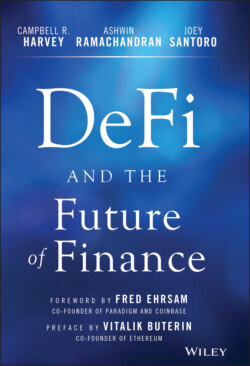Читать книгу DeFi and the Future of Finance - Campbell R. Harvey - Страница 15
CRYPTOCURRENCY
ОглавлениеThe most popular application of blockchain technology is cryptocurrency, a token (usually scarce) that is cryptographically secured and transferred. The scarcity is what assures the possibility of value and is itself an innovation of blockchain. Typically, digital objects are easily copied. As Eric Schmidt, the former CEO of Google, said,1 “[Bitcoin] is a remarkable cryptographic achievement and the ability to create something that is not duplicable in the digital world has enormous value.”
No one can post a false transaction without ownership of the corresponding account due to the asymmetric key cryptography protecting the accounts. You have one “public” key representing an address to receive tokens and a “private” key used to unlock and spend tokens over which you have custody. This same type of cryptography is used to protect your credit card information and data when using the Internet. A single account cannot “double spend” its tokens because the ledger keeps an audit of the balance at any given time and the faulty transaction would not clear. The ability to prevent a double spend without a central authority illustrates the primary advantage of using a blockchain to maintain the underlying ledger.
The initial cryptocurrency model is the Bitcoin blockchain, which functions almost exclusively as a payment network, with the capabilities of storing and transacting bitcoins across the globe in real time with no intermediaries or censorship. This is powerful value proposition gives bitcoin its value. Even though its network effects are strong, some competitors in the cryptocurrency space offer enhanced functionality.
